#Wire diameter
Explore tagged Tumblr posts
Text
Unlocking Precision: Measuring the Diameter of a Wire and Thickness of a Sheet with a Screw Gauge
The experiment to measure the diameter and thickness using screw gauge: Step-by-Step Guide Screw gauge measurement:Objective To measure the diameter of a given wire,the thickness of a sheet,and to understand the working and precision of the screw gauge. Screw gauge measurement:Materials Required Screw gauge Wire Metal sheet Notebook for recording measurements Screw gauge measurement: Principle A…
#Engineering tools#Experimental physics#Hands on learning#Lab skills#LEAST COUNT#Measurement techniques#micrometer#PHYSICS EXPERIMENTS#Precision measurement#Science experiment#Scientific instruments#SCREW GAUGE#Sheet thickness#STEM education#Wire diameter#ZERO ERROR
0 notes
Text
pvc electric red and blue wire #smartratework#tumblr
#flowers#aesthetic#alternative#grunge#1950s#cute#japan#60s#70s#80s#|| Smart Rate Work#Manufacturing encompasses a diverse array of processes and technologies aimed at producing a wide range of products#from everyday essentials to specialized components. Take wires#for instance: these are typically manufactured through drawing processes#where metal rods or strips are pulled through dies to reduce their diameter and achieve the desired thickness. This method ensures uniformi#crucial for applications in electronics#construction#and industrial settings.#On the other hand#the production of bottles involves molding techniques such as blow molding or injection molding. Blow molding heats plastic resin into a mo#used extensively for beverage containers and packaging. Injection molding#meanwhile#injects molten plastic into a mold under high pressure#ideal for producing intricate shapes with precision#like medical vials or automotive parts.#Both wire and bottle manufacturing rely heavily on materials science#engineering precision#and quality control measures to meet stringent specifications. Advances in automation#robotics#and sustainability practices are transforming these industries
2 notes
·
View notes
Link
0 notes
Video
youtube
Full Automatic Wire Drawing Machine Line For Sale at Factory Price🔥🔥🔥
#youtube#Full Automatic Wire Drawing Machine Line For Sale at Factory Price🔥🔥🔥 Working speed: 15ms; block diameter: 400mm; inlet and outlet wire d
0 notes
Text
"Scientists in Singapore have broken a long-standing limitation on the ability to generate electricity from flowing water, suggesting that another elemental force of nature could be leveraged for renewable electricity: rain.
With the simplest and smallest scale test setup, the team could power around 12 LED lightbulbs with simulated rain droplets flowing through a tube, but at scale, their method could generate meaningful amounts that could rival rooftop solar arrays.
Singapore experiences significant rainfall throughout the year, averaging 101 inches (2581 millimeters) of precipitation annually. The idea of generating electricity from such falling water is attractive, but the method has long been constrained by a principle called the Debye Length.
Nevertheless, the concept is possible because of a simple physical principle that charged entities on the surface of materials get nudged when they rub together—as true for water droplets as it is for a balloon rubbed against the hair on one’s head.
While this is true, the power values thus generated have been negligible, and electricity from flowing water has been limited to the driving of turbines in hydropower plants.
However, in a study published in the journal ACS Central Science, a team of physicists has found a way to break through the constraints of water’s Debye Length, and generate power from simulated rain.
“Water that falls through a vertical tube generates a substantial amount of electricity by using a specific pattern of water flow: plug flow,” says Siowling Soh, author of the study. “This plug flow pattern could allow rain energy to be harvested for generating clean and renewable electricity.”
The authors write in their study that in existing tests of the power production from water flows, pumps are always used to drive liquid through the small channels. But the pumps require so much energy to run that outputs are limited to miniscule amounts.
Instead, their setup to harness this plug flow pattern was scandalously simple. No moving parts or mechanisms of any kind were required. A simple plastic tube just 2 millimeters in diameter; a large plastic bottle; a small metallic needle. Water coming out of the bottle ran along the needle and bumped into the top section of the tube that had been cut in half, interrupting the water flow and allowing pockets of air to slide down the tube along with the water.
The air was the key to breaking through the limits set by the Debye Length, and key to the feasibility of electricity generation from water. Wires placed at the top of the tube and in the cup harvested the electricity.
The total generation rate of greater than 10% resulted in about 100 watts per square meter of tube. For context, a 100-watt solar panel can power an appliance as large as a blender or ceiling fan, charge a laptop, provide for several light bulbs, or even a Wi-Fi router.
Because the droplet speeds tested were much slower than rain, the researchers suggest that the real thing would provide even more than their tests, which were of course on a microscale."
-via Good News Network, April 30, 2025
#singapore#asia#rain#renewable energy#renewables#clean energy#electricity#science and technology#solarpunk#good news#hope
2K notes
·
View notes
Text
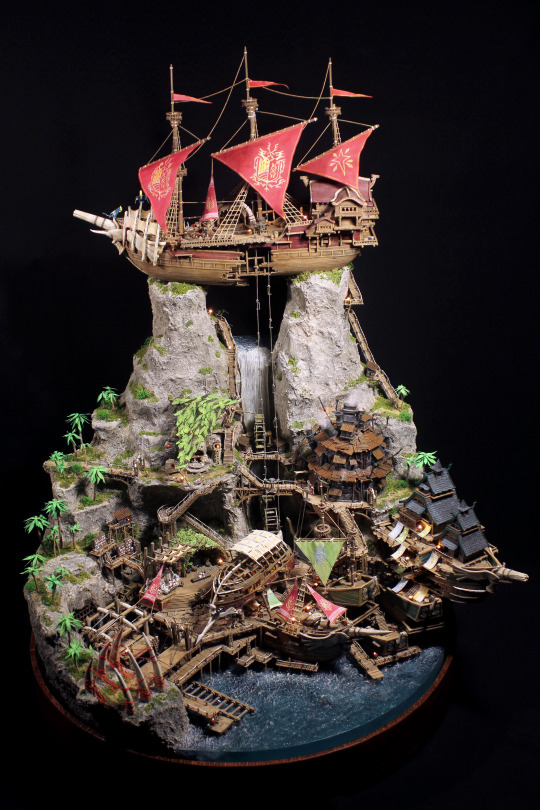
New World Headquarters for the Research Commission, Formation of The Hunter’s Guild: The Settlement of Astera or The Settlement of Astera or Astera (Monster Hunter: World) made by hand primarily from paper (also floral wire, toothpicks, epoxy resin) 28” x 20” diameter
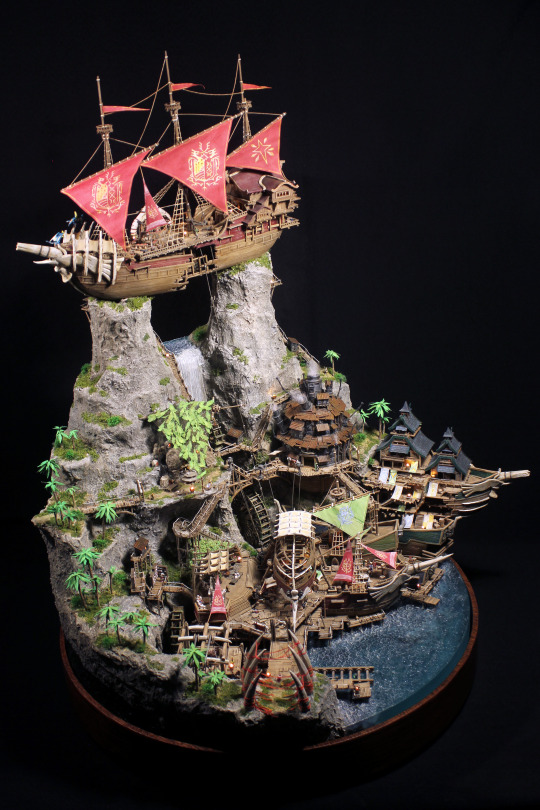
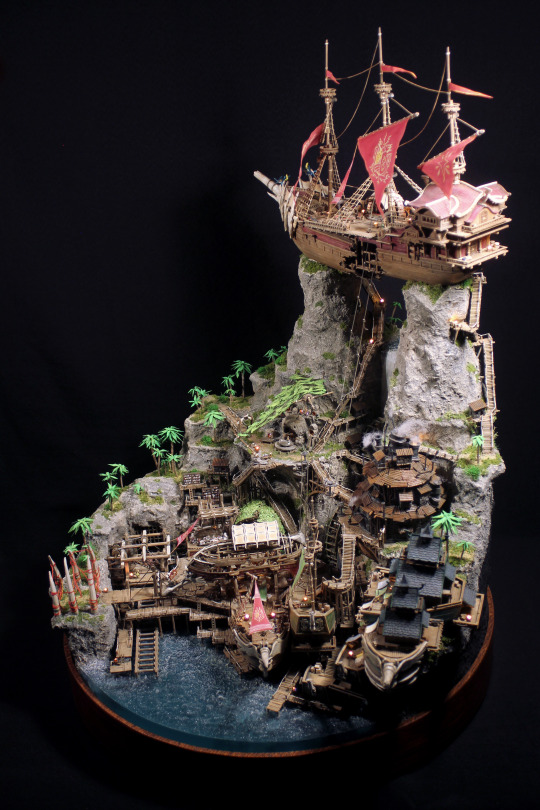

My largest miniature yet and certainly the most densely constructed. This piece took me 5 months, chipped through well over 1k blades, 4 pads of bristol paper, countless sheets of cardstock, 3 bottles of glue, 48 LEDs, and a liter of clear cast resin. For scale photo scroll all the way down!

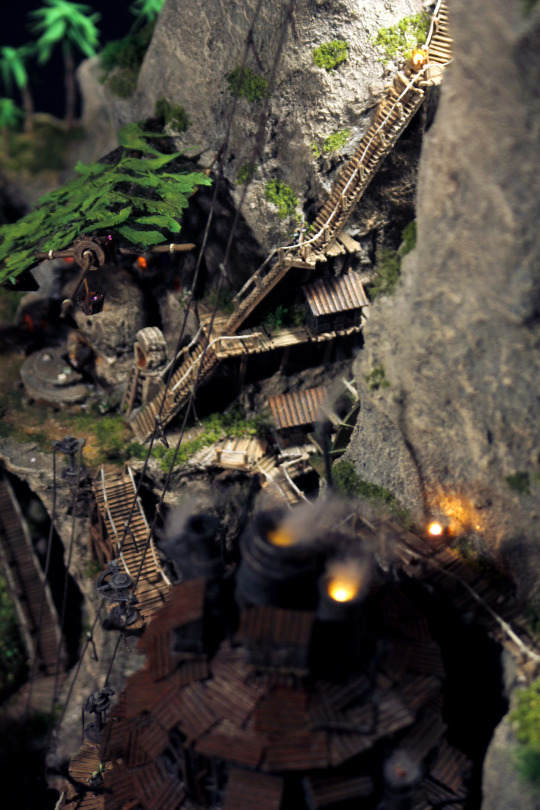

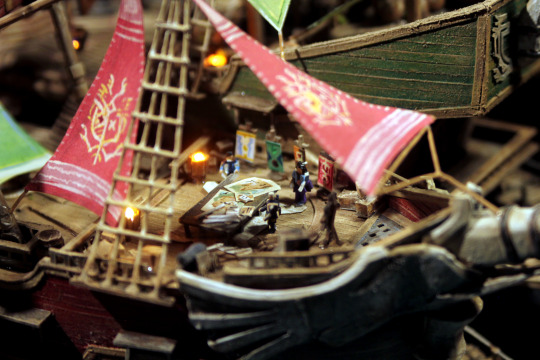


I kept a weekly journal documenting the process for free reads on my Patreon over here: https://www.patreon.com/collection/60826

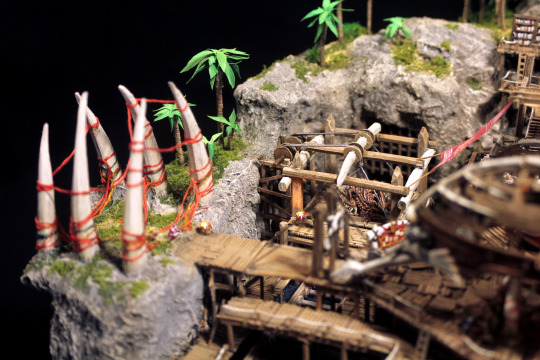
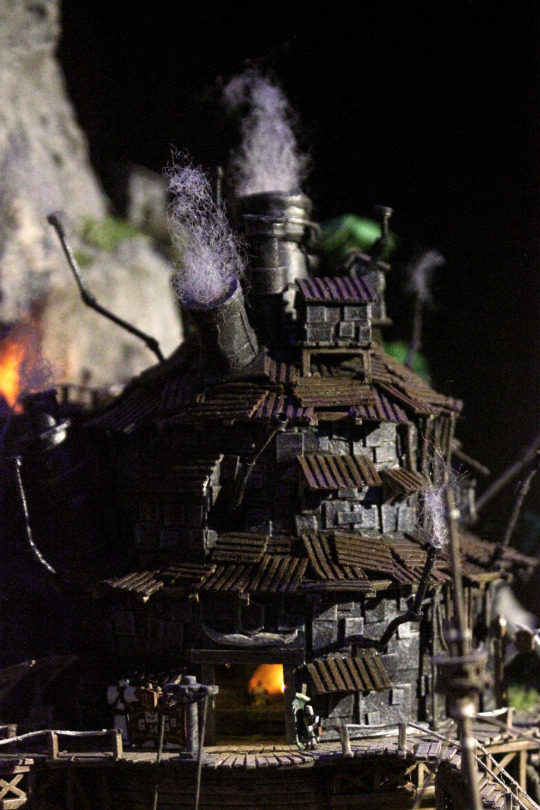
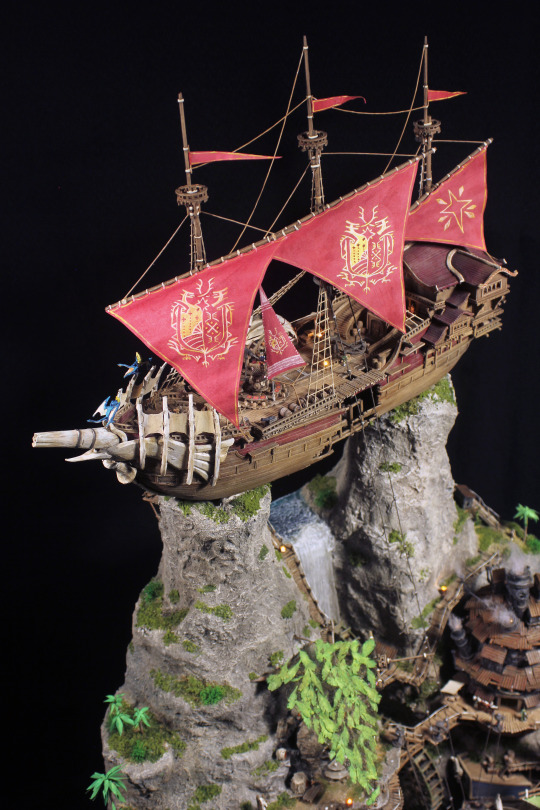

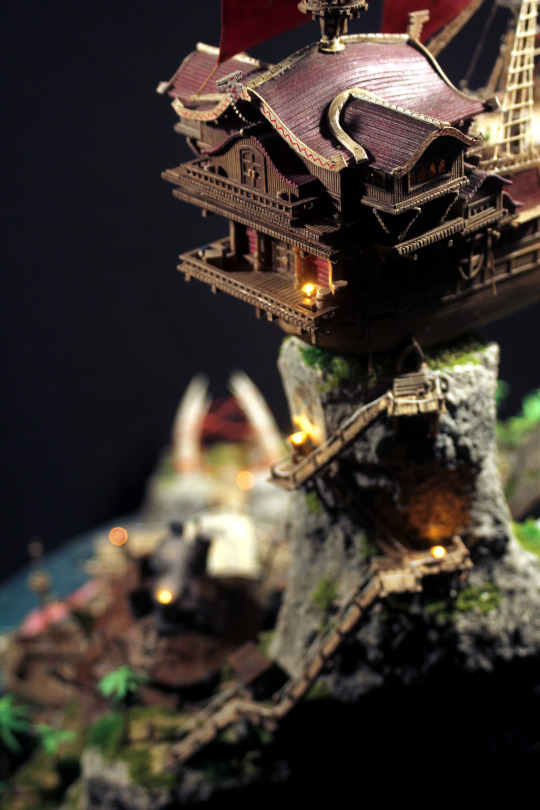
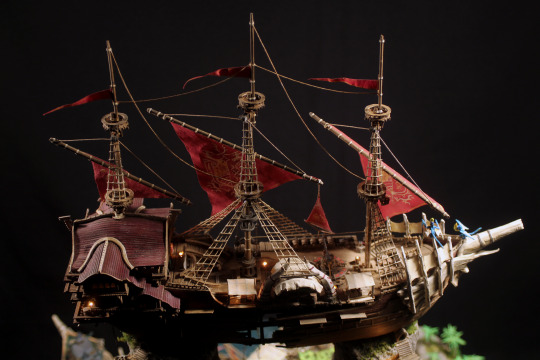


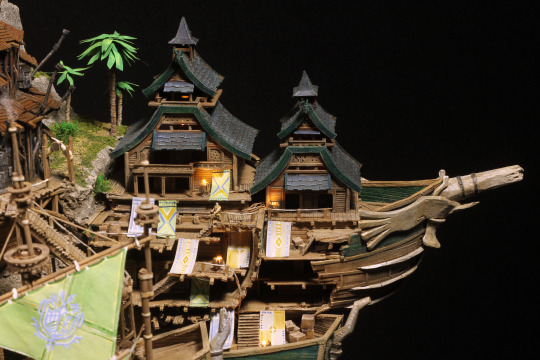
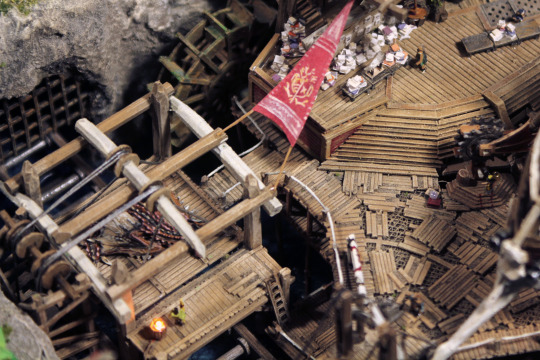

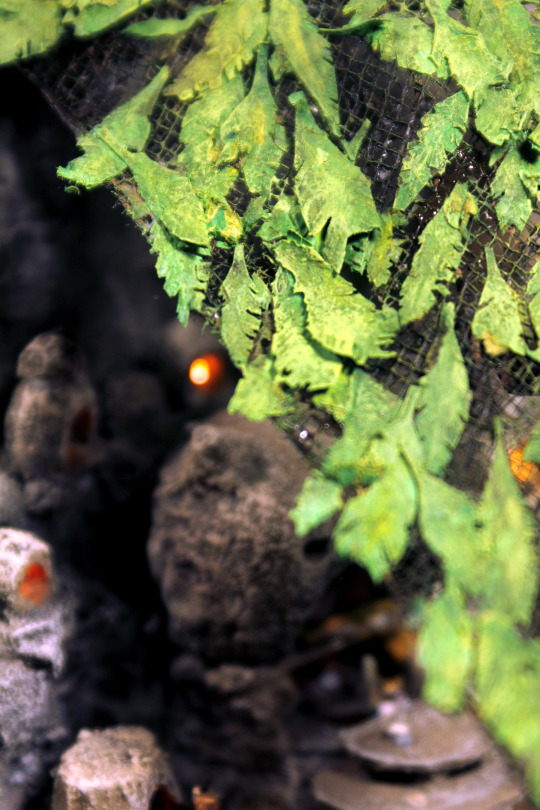
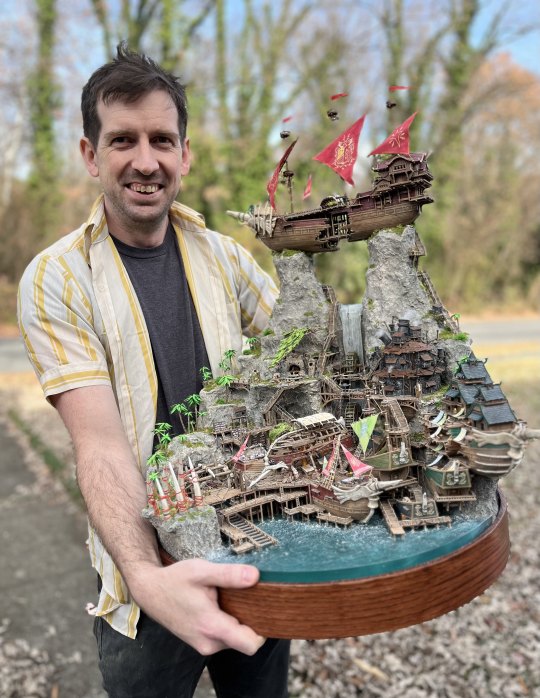
#monster hunter#monster hunter world#astera#ship building#scale model#painting#sculpture#papermodel#paper model#papercraft#paper art#miniatures#miniaturist#model making#capcom#monster
3K notes
·
View notes
Text
YEAH YEAY OKAY! here we go! welcome to i get to infodump about pens again, yay yippee!
what's the difference between ballpoints, rollerballs, and gel pens?
ballpoints, rollerballs, and gel pens all use a ball-socket mechanism that continuously coats itsself in ink as it rolls across a page. what makes them all different from each other is in the ink composition!!
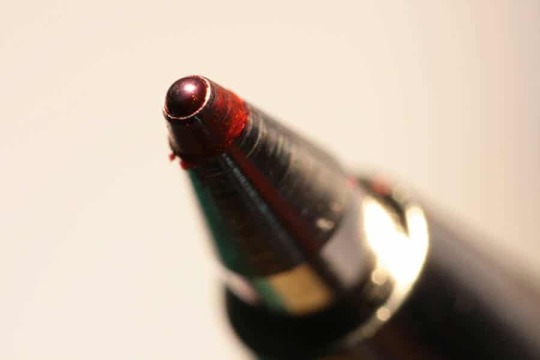
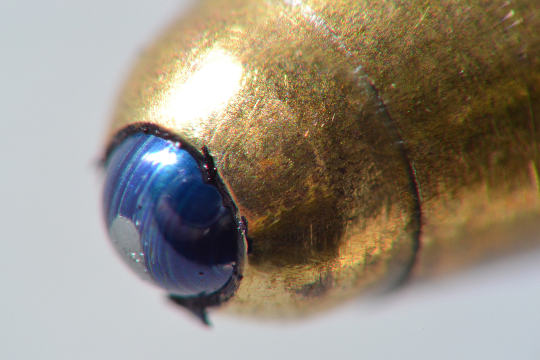
ballpoint pens have an oil based ink paste. the ink is very thick & requires more pressure to write with, and can get kinda skippy as the tip gets dirty or clogged, but is able to stick to many more surfaces like receipts, plastic, really shitty paper, etc. it can be hard to wash out of things that you get it on, since it's more waterproof than other inks.
one of the neat things about this type of ink is that you're able to shade with it by varying pressure. lots of artists make great use of this!
hybrid or low viscosity ballpoint ink is often just ballpoint ink with an added lubricant to make it write smoother and flow better.
rollerball pens use water based inks. fountain pens, felt tip pens*, and dip pens all usually use water based inks. because of this, rollerballs are very free flowing and rarely clog, but paper choice is more important and some folks can find them to be leaky or overly wet. the writing experience is not as glidey as a gel/ballpoint since the ink is not thick, but it doesn't need a heavy hand. rollerballs enjoy more colour options than ballpoints and can have very dark blacks, but aren't waterproof unless the ink is pigment based instead of dye based. *felt tip pens feel very different than any of the other pens on this list cause of the soft point, they put out ink in a very even and somewhat dry way, and can also use alcohol inks, like copic markers. alcohol inks soak very deep into the page and dry very fast, and blend very differently. i'm not as familiar with them!
gel pens use inks that are made of pigment suspended in a water based gel. these inks tend to be very thick and put out a wet line that takes a longer time to dry. gel pens are most likely to clog and skip due to this, since the ball is not as evenly coated in a substance so thick. gel pens do have the widest colour options and can be fully opaque (ie. pastels, whites, etc) but are often very frustrating as they clog up and get old and dried out.
as a bonus, true technical pens are a whole different kind of beast and have very specific standardized nib sizes and colours. cad software has largely replaced the need for extremely precise technical drawing, but artists still like pens like the rapidograph! they're made differently everywhere but generally, instead of a ball, there is a small tube of a precise diameter with a little wire inside it that controls the ink flow. they can't be held at a lot of angles and aren't as versatile as other pens, but they put down incredibly crisp lines.
yippee yay pens!! wahoo!!
4K notes
·
View notes
Text

Fast #lifehack - need to make a projector fast? I made and tested this puppy with great success. (Yes a dark area works best, or test it at night .)
1. Grab a shoe box or a sturdy cardboard box with a top or closing ability..
2. Grab a magnifying glass of some sort.. (got this one on amazon for 10 bucks)
3. Cut a hole in the box the size of the magnifying glasses diameter.. (I messed up the first one but got it on the second try)
4. Place the magnifying glass inside..
5. Grab your smartphone.. put on a video / piece of media.
6. Place it inside the box facing the magnifying glass, you will need to prop it up using some flexible wire or something small enough and heavy enough to hold it up. I found a rock 🪨 :)
7. Test it against a blank wall space.
And, life is forever changed!!
#hack #technology #ephemera #projector #diy #diyprojects
305 notes
·
View notes
Text
Yall I really need some ultrakill smut fiction recommendations. Please. Give me yalls best.
I've already got like 43 tabs. Let me list the fics I've got.
!!!THESE FICS AREN'T MINE!!! ALL ARE FOUND ON AO3!!!
- sort it out in new perspectives, reused and defective by peachybutch (v4v) not smut (for now?)
- Wired To You by TrashSkull (Gabv1el)
- Fuckatorium by Bemused_Illusionist (Minos x V1)
- The Night Breathes (Kiss Me) by ZORIAC (Gabv1el)
- Mandala by GhostOfTheWorld (Gabv1el) not smut
- An Exercise in Futility by an orphan account (Gabv1el)
- The vulnerability of the unholy by stereoberry-crisis (stereoberryes), stereoberryes (Gabv1el)
- The entire MonsterKill Exploration series by TrashSkull (multiple ships)
- Ritual by @postbshours (My mootie) (Gabv1el)
- Machines Know How to (Death) Dance, Fortunately! By DennisLessing, vegasolari (Gabev1el)
- A Brazen Disregard for Chastity by Omnomftw (Gabev1el)
- One is good, but two is better by HieronymusNosk (GabrielxV1xV2)
- The entire Conducting Experiments collection by HieronymusNosk (mostly Gabv1el)
- Fumbling towards ecstasy by Hatchling524 (multiple ships)
- Digital Obsession by ThrowmeawayintoSipscoPool (V1/V2 x reader) not smut (for now)
- TOOL-ASSISTED SPEEDRUN by karmatens (Gabev1el)
- Immaculate Conception by postbshours (Gabv1el)
- Why don't we just sit here for a while? By etherealpilled (v4v)
- Even if I could, I wouldn't cry for you by Muinomikuj (v4v)
- DEATH ON YELLOW WINGS by BeDactyl (Gabv1el) not smut (also can be read as platonic)
- Overindulgence by HieronymusNosk (Gabv1el)
- Growing Pains by @dynafire (hi pooks) (Gabv1el) not smut
- Good Dog by SexySpectacles (Gabv1el)
- Immaculate Conception by my pookie postbshours (Gabv1el)
- All The Right Parts by smutposting (v4v)
- rumble support by Bemused_Illusionist (Gabv1el)
- The older experienced child and the younger bombastic brother by Sasygigikitty (Gabv1el)
- fleshlight diameter by Anonymous (Gabv1el)
- dreams of you in places I've not seen before by hotlineamy (Gabv1el)
- my angel by j0n43ll (Ferrygabe) not smut
- Those Who Falter and Those Who Fall by MyceNet (Gabv1el)
- don't have to try with more than just your skin by
hotlineamy (Gabv1el)
- Nightcap by hotlineamy (Gabv1el)
- Flight by LocallySunny (Gabv1el) not smut
- toccata (& fugue) by dcb_z (Gabv1el)
- Why don't we just sit here for a while? By
etherealpilled (v4v)
!!!THESE ARE MOSTLY SMUT!!!! SOME AREN'T SMUT!!! NONE OF THEM ARE MINE!!! I JUST LIKE TO GOON!!!
#ultrakill#im going insane#ultrakill v1#v1 ultrakill#gabriel ultrakill#gabv1el#ultrakill gabriel#im going feral#v1 x v2#v4v#ultrakill v2
112 notes
·
View notes
Text
Writing Notes: Percussion Instruments
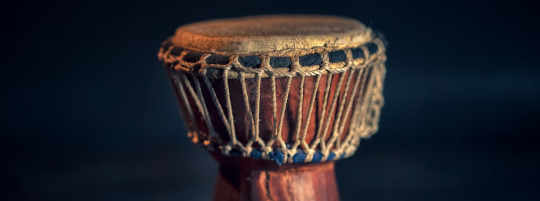
The percussion family of musical instruments - consists of membranophones and idiophones.
Membranophones - (or drums) are instruments that make sound when a player strikes a membrane that is tightly stretched over a frame.
Idiophones - instruments that produce sound when the entire instrument vibrates in response to being struck.
Percussionists play their instruments with their hands or with beaters, a collective term describing drumsticks, mallets, rods, or wire brushes.
Types of Membranophone Percussion Instruments
Nearly every genre of music features some form of drumming, and there are innumerable types of drums across world cultures, including:
Congas: Congas are tall, deeply-pitched hand drums that stand on the floor or on study chrome hardware.
Bongos: Bongos are tall hand drums that are smaller than congas and produce a higher pitch.
Timbales: Timbales are small metal-frame drums that are mounted on a stand and played with beaters. A timbale player usually has two drums, plus cowbell and perhaps a woodblock, as part of their kit.
Mridangam: Thought to be the oldest type of drum still in use, the mridangam has two drum faces—a left face and a right face. Traditional mridangam players apply a mixture of flour and water to the left face to lower its tone when playing.
Tabla: The tabla is the most common percussion instrument in traditional Indian music, typically paired with a sitar. Tablas consist of two drums—a "male drum" that produces a bass tone and a "female drum" that produces a tenor tone.
Djembe: A djembe is a goblet-shaped African drum that a player holds between their knees and plays with their hands.
Talking drum: A talking drum is an hourglass-shaped drum with drum heads on either end. Talking drums get their name from the notion that they can mimic sounds of human speech.
Ngoma: A ngoma is a barrel-shaped African drum that sits on the floor. The drummer strikes it with large wood beaters.
Orchestral bass drum: Similar in origin to the bass drum found in a standard drum set, but much larger in diameter, the classical bass drum hangs from a frame. The percussionist strikes it with handheld mallets.
Tenor drum: Higher-pitched than a bass drum but lower pitched than a snare drum, a tenor drum is round and of medium depth. The drummer plays it with a mallet or a drumstick.
Side drum: The term "side drum" is used in classical music to describe a snare drum, usually with its snare disengaged. Side drums feature prominently in most contemporary classical music, whether or not they're part of a standard drum set.
Bodhran: A bodhran is a traditional Irish drum that sometimes finds its way into orchestral music, particularly when composers hail from the British or Irish isles. A bodhran resembles a tambourine without any jingles. The player strikes it with a small beater. Most bodhrans still are made with real goat skins.
Timpani: Also known as kettle drums, timpani sets consist of massive drums that stand on the floor in front of the player, who strikes them with felted mallets. Timpani pitches can be adjusted using a foot pedal, which loosens and tightens the drum head.
Kick drum: Also known as a bass drum, a kick drum is a large, deep-sounding drum that sits on the floor and is played with a foot pedal.
Snare drum: A bright, trebly drum that features metal snare wires running beneath its lower drum head. Typically, a drummer plays the snare with their non-dominant hand. Larger, body-mounted snare drums are a mainstay of marching band music.
Floor tom: A deep, low-pitched tom-tom drum that stands on legs near the drummer's dominant hand.
Rack toms (sometimes called a hi tom and a low tom): This pair of tom-tom drums hangs above the kick drum. They produce a higher-pitched sound than the floor tom.
Tambourine: Tracing back to the Middle East, a tambourine can be part of a drum set, either mounted as a standalone instrument or placed atop a hi-hat. A tambourine can have a drum head or it can exclusively produce sound via its zils (or jingles), which are metal discs mounted around the tambourine frame. Some players opt for a pandeiro, which is a close relative of the traditional tambourine.
Surdo: An unpitched Brazilian variant on the bass drum, played with handheld beaters.
Types of Idiophone Percussion Instruments
Idiophones produce sound when a percussionist strikes them, causing the entire instrument to vibrate. There are many enduring idiophones throughout the world of music, including:
Cymbals: Most cymbals are curved brass discs appearing in a wide array of sizes. Drum kit cymbals include a hi-hat, ride cymbal, crash cymbal, and splash cymbal, each mounted on a cymbal stand and played with beaters. Orchestral and marching band crash cymbals appear in handheld pairs; they produce sound when a player slides one cymbal past the other. Finger cymbals, as their name implies, are small enough to be worn on the player's fingers.
Crotales: Also known as antique cymbals, crotales are made up of a collection of small pitched cymbals and may be found in everything from classical music to 1970s progressive rock.
Claves: Wooden sticks that click together to produce an unpitched sound. They are a mainstay of salsa music.
Temple blocks: A series of pitched woodblocks popular in classical ensembles.
Agogo: An unpitched metal bell (or pair of bells) often featured in samba music.
Ganzá: An unpitched metal rattle developed in Brazil and popular in Brazilian samba.
Headless tambourine: This instrument is a tambourine without a membrane. It produces sound via the vibration of the frame and jingles.
Slit drum: Also known as a log drum, the slit drum is not a membranophone despite its name. Rather, a slit drum is an idiophone made from a hollowed log.
Udu: An untuned idiophone resembling a hollow jug.
Cajón: Originating in Peru, a cajón (or cajón de rumba) is a hollow wooden box that usually features internal snares on one side. A player sits on the cajón and strikes it with their hands (and occasionally beaters).
Gong: A suspended metal disc found in both Western classical and Eastern traditional music. Orchestras particularly favor a type of gong known as a tam-tam.
Maracas: Originating in Venezuela but popular throughout Latin American music, maracas are wooden shakers with handles.
Castanets: Castanets are handheld wood idiophones that come in pairs. They make a clicking sound when the player snaps two of them together.
Güiro: An idiophone made from a dried gourd. Typically, a percussionist plays güiro by rubbing wire brushes against it.
Shekere: A dried gourd covered with a netting of beads. Originally from West Africa and popular in Latin American traditions, it produces sound when shaken.
Tubular bells: These are pitched chimes that a player strikes with beaters.
Mbira: Also known as an African thumb piano, a mbira contains individual keys that a player presses and releases, causing them to vibrate.
Cabasa: A type of African shaker made by wrapping metal chains around a wooden cylinder.
Xylophone: A pitched percussion instrument made from wooden bars laid out like a piano keyboard, which the player strikes with felted mallets.
Marimba: A musical instrument much like a xylophone but with a greater range and resonators beneath its wood bars.
Vibraphone: An adaptation of a xylophone, the vibraphone has metal bars and a built-in electric resonator that projects the instrument's sound. A vibraphone is essentially a plugged-in metal marimba.
Glockenspiel: A smaller member of the xylophone and vibraphone family, containing small metal bars that produce a definite pitch with numerous overtones.
Steel drum: An idiophone made from a concave metal drum. The player can attain different pitches by striking different parts of the drum.
Cowbell: A hollow metal idiophone named for a similar device hung around the necks of some domestic cows.
Source ⚜ More: Writing Notes & References ⚜ Writing Resources PDFs
#percussion#musical instruments#music#writeblr#worldbuilding#writing reference#writing inspiration#writing ideas#literature#writers on tumblr#dark academia#culture#spilled ink#writing prompt#creative writing#light academia#writing resources
65 notes
·
View notes
Text




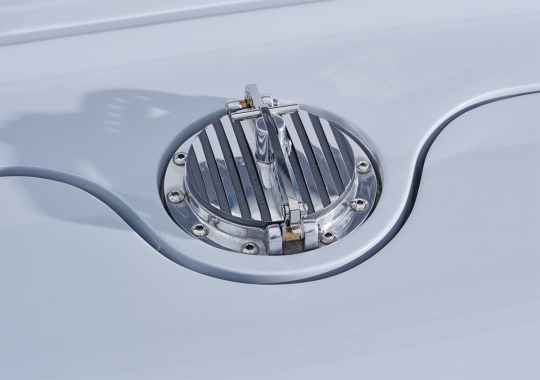
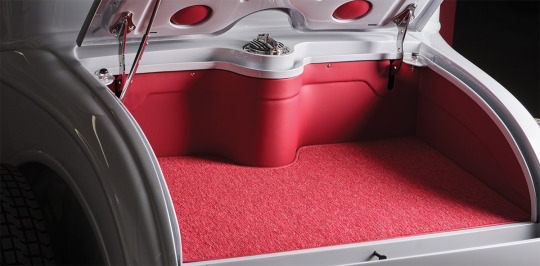



1930 Ford Highboy Coupe
There’s always lots of detail work with any build and this ’30 Ford highboy coupe is no exception. Look closely and you will find Craftworks Fabrication handmade steel motor mounts. The license plate and valve covers were painted by Jeremy Seanor of Luckystrike Designs. He also painted all the accompanying engine and tranny parts. The powdercoat was handled by Pittsburgh Powder Coat while the chrome plating was conducted by Jon Wright’s Custom Chrome Plating.
The chassis is comprised of a Roadster Shop custom frame that was stepped, stretched, and features contoured ’32 Ford-style framerails. It was also then boxed, capped, and has hole punch flared front framehorns. From here the frame is outfitted with a Super Bell 4-inch drop, drilled and plated I-beam axle, low-profile monoleaf spring with Ridetech tubular shocks paired to custom-made drilled billet radius rods from Johnson’s Hot Rod Shop. Steering falls to the Flaming River box and a LimeWorks Hot Rod column topped with a four-spoke Billet Specialties Sprint Car–style leather-wrapped wheel. In back there’s a Currie 9-inch rearend outfitted with 3.70 gears, 31-spline axles, QA1 coilovers, a Pete & Jakes Panhard bar, and a parallel four-link setup. Braking is a combination of disc/drum front to rear. The forward braking dark gray–painted Wilwood Dynalite calipers are neatly hidden behind the Pete & Jakes finned backing plates. While in back the 9-inch is outfitted with 11-inch brakes, this time hidden beneath the SO-CAL Speed Shop finned drums all the while the chassis rides on a full set of 16-inch Dayton wire wheels wrapped with Coker/Excelsior rubber measuring 5.50R16 in front and 7.00R18 in the back.
All hot rods have something fun settled between the ’rails and beneath the hood (well if they have a hood). In the case of our ’30 Ford highboy coupe it sure appears to be a vintage Ford Y-block but after more than a cursory look we begin to see the telltale signs that there’s something more. Indeed, while it may look like a Ford it truly is a 376-inch LSX iron block, with aluminum heads and ARP studs, plus adapter-equipped small-block Ford (Windsor) valve covers all from Don Hardy Race Cars and then assembled by Talik and Marc Mullin. The intake is an Edelbrock LS dual quad with a pair of Thunder AVS EnduraShine carbs dressed in OTB air cleaners. Delivering the gas from the Tanks stainless reservoir is an Earl’s Performance billet fuel pump. More engine accessories include an MSD 6AL box to go along with the MSD billet Ford small-block distributor that functions through a timing cover adapter from Chevrolet Performance all the while using an MSD coil and Lokar vintage plug wires. Powermaster also supplied the alternator and starter, the battery is an XS Power AGM, and a Wegner Motorsports water pump is used as well as a Wegner front accessory drive unit. This 500-plus hp V-8 utilizes custom headers made at Craftworks Fabrication based on Ultimate Headers LS header flanges. The pseudo-Ford small-block is backed up to a TCI StreetFighter 700-R4 with a 2,800-stall speed converter operated by a Lokar shifter. The trans cooler comes by way of Derale Performance and moves the power through a 3-inch-diameter custom-made driveshaft.
216 notes
·
View notes
Note
(Felicity: so this is really just the starter and I’ll reply from the Arson Murder Jaywalking Trio blog after)
Colin (and Argyros if she’s here) exit the portal through a dark wooden door with a simple brass knob into an odd-looking room. It’s square with each wall being about 15 feet long, but the most noticeable thing is that brass lines inlaid into the floor, corners, and ceiling split the room into four triangle-based quarters, with the one they’re currently standing in having a simple wooden floor, clean white wall, abstract wall art, fuzzy pastel green welcome mat, and wire coatrack, making it reminiscent of a cozy modern home. The quarter to their left has a much more antique vibe to it, the floor being wood in a different shade, and more worn looking, the patterned wallpaper being a faded magenta that blurred into the varied yet never too bright colors of the many, many photos pinned onto the wall around the door. There are pictures of beautiful scenes, snow fields, sunsets, forests, but there are no notable beings in them, no hints to the inhabitants of this strange little corner of the multiverse or the individual who must’ve taken them. Carved into the door on this wall are the words “If you’re seeing this, it means I’m home, feel free to come in if you can.�� in a rough, simplistic writing, with a rolled-up scroll and pen pinned on top- if the scroll was unrolled, it would cover the writing. A creative way for visitors to leave messages to whoever lived here. The quarter directly across had a stone brick construction, with an archway full of blue light acting as the portal and a hanging tapestry of a clear sky and bright sun for a door. On the walls to its sides were beadwork hangings, depicting a starry night sky with a crescent moon and snowy owl flying about, and what appeared to be a mammoth made of ice playing about in the snow. Upon closer inspection, the snowy owl seemed to be made of snow as well. Next to the door is a tall flowerpot overflowing with crawling pink-flowered vines that have spread onto the floor and walls, and a small dresser with a pair of snow boots on top. The boots don’t look quite big enough for an adult, instead made for maybe an older child in their early teens. The wooden rafters holding up the upper walls and ceiling were decorated with preserved flowers of every kind, giving the room a pleasant herbal aroma. The final quarter, the one to their right, had a traditional Japanese theme, with woven floor mats and paper wall panels painted with cranes in a marsh and a few scattered lines of calligraphy. In a cylindrical frame in the corner are rolls of painted paper that could likely be used to swap out the designs on the walls. In the other corner is a discreetly hidden set of light switches disguised as a candle holder- the candle it held was only a fraction of the height of the stand and the lower portion could open to reveal the controls. The portal door is a sliding door that could’ve easily been mistaken for a wall panel if it weren’t ever-so-slightly open, a crack of white mist pouring through. In the middle of the room, over the intersecting divider lines, is a small table resembling a tall stool, being 3 feet tall with a circular top a bit more than 1 foot in diameter. On it is a singular file folder, the papers inside peeking out. Do they go through any of the doors? Do they check the file folder? Do they mess with the light switches or any of the other stuff in here?
"How fascinating..." Colin tilts his head, looking around the room. This was definitely a new and unfamiliar place. He decides to check the file folder; it's best to know what he can about this place and who's here before he investigates them directly.
"Seems familiar!" Argyros grins, looking around. She thinks for a moment, before skipping over and knocking on the door with the carved message.
"Is it a good idea to immediately start bothering people?" Colin asks lightheartedly, an eyebrow raised as he glances at Argyros.
"It'll be fiiine!" Argyros looks at Colin over her shoulder, eyes closing for a few moments as she grins.
88 notes
·
View notes
Note
Can I ask what your job is? Not asking for like. The name of the lab you work at or anything! Just general if you’re comfortable with that! I see pictures of you in a lab with Big Machine and Cylinders and my interest is peaked
totally! i genuinely, unironically teleport electrons for a living.
I study novel superconductors for the purpose of quantum computing. These are materials with zero electrical resistance, so electrons just slip slide right on through them like a trout through a pristine mountain stream. this is in contrast to everyday materials that have significant resistance, even the wires we use for everyday electric currents in our devices and walls have significant energy loss. this is why i cant hook up a regular wire stretching from california to new york and carry a current the whole way. (not to quote megamind but just because somethings a conductor, doesnt mean its a SUPERconductor)

To study the properties of these superconductors, i quite literally teleport electrons from an atomically sharp, one singular atom wide tip into the surface of the material when the tip and the sample are about one or two atomic diameters apart. The tip and the material are so close that quantum mechanics kicks in and the electrons will spontaneously quantum tunnel from one location to another. As these electrons quantum tunnel across the junction, i interpret the flow of electrons as a tunneling current, looking to see places where its easier or harder for electrons to make the jump. I then use those fluctuations to get information about the sample.
this actual "teleportation" can happen on a stage smaller than a single red blood cell. But due to the nature of superconductors, these experiments have to be done at temperatures just barely above absolute zero, in ultra high vacuum at pressures one billion times below atmosphere (our vacuum actually beats the vacuum of space outside the ISS!), and with extreme vibration and noise isolation; all of this is why the room and the equipment looks as funky as it does!
80 notes
·
View notes
Text
Ignition
Once the Galactic Coalition had (without other realistic options) given Humanity an equal position among the governing bodies, despite the fact they were a single planet race, the initial dread of what they would do eased. A little. When they showed how they powered their impossibly massive vessels, the fears of our ancestors who deemed the Responsibility Barrier a necessity reemerged a thousandfold.
The Humans, with a slight grin, said "Solar power, of course."
They took a delegation within the bowels of one of their smaller, civilian research craft, which was still bulkier, better armored, and more worryingly - better armed than most flagships of the other predator-races. Were we not able to see with our own eyes their actual, what they aptly call, Dreadnoughts, from distances you would normally need a telescope, we would have assumed this was their mightiest warship. Yet it was just one of hundreds.
As we passed through the ludicrously thick and seemingly excessive number of bulkheads and shielded and compartmentalized hallways, the ever present hum of raw power beneath our feet gradually became nerve-wracking. What is that? It reminded us of stories told by those who traveled near Black Holes - of the sheer vastness and infinite apathy they felt from the all consuming entities.
A dozen or so biometric gates later, we were greeted by a gigantic sphere, easily a hundred and fifty meters in diameter, an abomination of reinforced panels, wiring, heat pumps, and countless tubes, hanging from numerous power conduits in the middle of an even more massive chamber from behind our observation platform. A true, pure fusion reactor. And there were Humans, in full protective suits at least, working directly next to it within the ominous chamber.
"We wanted to give you a demonstration of our advances in the past millennia, so please observe as we turn on this one."
This one? As in... the power we were feeling was not from this monstrosity? We had to ask.
"Oh, of course not, this ship has three such reactors, we recently performed a full maintenance on this and decided to delay reactivating it for you to see."
The delegates' mouths (or equivalents) were agape. Sure, nuclear fusion is known far and wide, but due to it's high potential for cataclysmic failure, or worse, deliberate destruction, the vast majority of such reactors were mostly found in deep space stations where solar radiation was scarce. Background radiation converters, while efficient at what they do, were nowhere sufficient enough for anything more than as passive emergency battery chargers. And no civilization kept fusion reactors anywhere near populated or colonizeable planets.
Yet here they were, looking at one nearly five times larger than any other known or attempted. And there were three on this ship alone. They counted hundreds of similar size, a few dozen of their Dreadnoughts, thousands of smaller vessels ferrying between the stations, the surface, and other larger ships. Countless world ending bombs-in-waiting right around the Humans' only home.
"Yeah, us science ships get the biggest ones, kinda need the extra oomph for our projects. The military kids like their redundancies, so theirs are smaller."
A slight relief.
"I think their newest capital ship, the UGSF Caliban of York, has fifteen, each about half ours."
A few delegates passed out. Their attendants rushed to salvage some dignity, but Captain Knoslark of this vessel, The Radiant Dusk at Everest, didn't seem surprised or offended and simply waited for the delegation to regain composure before continuing.
"This is my favorite part."
He said quietly with a glint in his eyes, then his tone changed to a more formal and authoritative one.
"Chief Engineer Ira Tameki, status of Reactor 2."
"All green, Captain. She's ready to purr to life at your command."
"Good. Then," his tone shifted once again, to a far more theatrical one as he took a pose, half turning his body and extending his right hand towards the reactor, index finger pointing dramatically. As he pronounced every syllable of the next word, there was a silent resigned sigh from his crew:
"ignition!"
Outwardly, nothing of significance changed. The engineers clicked at their consoles, bars slowly rose and everyone was deliberately doing their best to make it clear they were ignoring the fact that the captain was still in the same pose.
There was a muffled thump from the chamber, then the hum beneath their feet became a rumble for a few moments before steadying back to a now slightly more intense almost-buzz. Physically, nothing all that noteworthy. Mentally, everyone in the delegation was in true shock as they fully understood what they had just witnessed done all too casually:
The birth of a star.
#humans are deathworlders#humans are space oddities#humans are space australians#humans are space orcs#humanity fuck yeah#carionto
551 notes
·
View notes
Text
First Sight (Chapter 7 of 7)
The syringe felt precisely weighted in Carmella's hand as she turned back toward Audrey, the clear Adenosine solution catching the examination room's fluorescent light. She approached the reclining chair with measured steps, her clinical gaze assessing the naked form before her with practiced detachment that grew more difficult to maintain with each passing second. The electrodes remained attached to Audrey's freckled skin, the wires creating a technological tether between her exceptional physique and the steadily beeping monitor that continued to document each perfect contraction of her heart.
"I'll need to access a peripheral vein," Carmella explained, her voice maintaining its professional timbre despite the flutter beneath her rib cage. "The medication requires direct venous administration for accurate pharmacological stress simulation."
Audrey extended her right arm without hesitation, her musculature shifting beneath freckled skin with elegant precision. The movement highlighted the exceptional vascularity along her forearm—prominent vessels mapping pathways that Carmella's trained eye followed with inappropriate appreciation.
"Perfect," Carmella murmured, the word escaping before she could contain it, its clinical assessment compromised by the warmth in her tone. She applied the tourniquet with practiced efficiency, the blue latex band contrasting vividly against Audrey's skin as she secured it at the precise tension required to restrict venous return without compromising arterial flow. Audrey's veins responded immediately, rising to prominence beneath her skin—a testament to her exceptional hydration status and minimal subcutaneous fat.
Carmella's fingers palpated along the antecubital fossa, identifying the optimal insertion site with unconscious precision. The median cubital vein presented as an ideal target—straight, well-fixed, with sufficient diameter to accommodate the catheter while minimizing the risk of infiltration. She cleansed the site with methodical circular motions, the alcohol swab leaving a cool path that evaporated quickly against Audrey's warm skin.
"You'll feel a slight pinch," she warned, the standard phrase falling from her lips automatically as she positioned the needle at the optimal angle of approximately fifteen degrees. The venipuncture was flawless—first attempt cannulation with minimal tissue disruption. Carmella observed the immediate flashback of blood into the catheter hub, confirming perfect placement within the vessel lumen. She advanced the catheter with gentle precision, withdrew the introducer needle, and secured the IV line with a transparent dressing, all while maintaining sterile technique despite the tremor that threatened her usually immaculate control.
"Excellent vein," she noted, her clinical observation undermined by the slight elevation in her voice. "The Adenosine will circulate rapidly through your system." Audrey smiled, the expression transforming her already striking features. "I've been told I have exceptional circulation," she replied, the casual comment carrying suggestive undertones that registered in Carmella's nervous system with the precision of an EKG.
Carmella connected the prepared syringe to the IV line, her fingers brushing momentarily against Audrey's skin in the process. The brief contact sent another jolt of awareness through her already heightened nervous system, but she maintained her professional facade with desperate determination.
"The effects will manifest within approximately thirty seconds," she explained, her voice steadier than her pulse as she began the injection. "You'll likely experience flushing, possibly shortness of breath, perhaps a sensation of chest pressure. These responses are expected and temporary."
The clear solution disappeared into Audrey's vein with metronomic precision as Carmella depressed the plunger at the exact rate specified in cardiovascular pharmacological protocols—6 milliliters per minute, neither too fast to trigger hypotension nor too slow to compromise test efficacy. She monitored the injection site for any signs of infiltration, though the perfection of her venipuncture technique made such complications highly improbable.
The ECG monitor registered the first pharmacological effects within twenty-three seconds—precisely within the expected timeframe. Audrey's heart rate began to accelerate from her resting 72 beats per minute, climbing steadily as the Adenosine triggered massive peripheral vasodilation. The monitor's beeping increased in frequency, documenting the progression with electronic precision.
Carmella observed the physiological cascade with clinical fascination that barely masked her deeper interest. A flush spread across Audrey's freckled chest, the capillary dilation creating a visible map of the drug's systemic effects. Her respiratory rate increased to approximately 18 breaths per minute, her chest rising and falling with greater amplitude as her body compensated for the increased oxygen demand.
"How are you feeling?" Carmella asked, her clinical question standard procedure during pharmacological testing. "Warm," Audrey replied, her green eyes brightening with an internal heat that seemed to transcend the medication's physiological effects. "My heart is racing, just like when I first saw you watching me at the gym."
The statement hung between them, its directness stripping away another layer of professional pretense. Carmella's cheeks flushed with heat that had nothing to do with the ambient temperature of the examination room, the capillary response mirroring Audrey's drug-induced flush with uncanny symmetry.
As the Adenosine reached peak effect, Audrey's chest began to rise and fall with visible force, each heartbeat creating a perceptible movement beneath her sternum. The freckles across her skin seemed to dance with the rhythm, creating patterns that drew Carmella's gaze with magnetic intensity. She found herself tracking the pulse with inappropriate fixation, her lower lip caught between her teeth as she counted the visible contractions.
Audrey noticed the focus of Carmella's attention, her eyes narrowing with knowing perception. "My heart is pumping so hard now, doctor," she said, her voice dropping to a sultry tone that sent vibrations through Carmella's already heightened nervous system. "You should hear it in action."
The suggestion triggered an immediate autonomic response in Carmella—her pupils dilated fully, her own heart rate accelerated to approximately 110 beats per minute, her peripheral blood vessels expanded with a rush of warmth that defied her attempts at professional distance. The stethoscope around her neck suddenly felt heavy with potential, the instrument both a symbol of her medical authority and a conduit for the intimate connection she desperately desired.
"Yes, I should auscultate your heart during peak effect," Carmella agreed, the clinical justification transparent in its inadequacy. Her hand rose to the stethoscope, fingers curling around the familiar tube with unnecessary force. "It's standard protocol during pharmacological stress testing."
Before she could position the earpieces, Audrey's hand closed over hers, the contact sending another jolt of awareness through her nervous system. With deliberate slowness, Audrey took the stethoscope from Carmella's trembling fingers, the transfer of the instrument representing a seismic shift in the power dynamic between them.
Carmella's professional mask cracked visibly, her expression betraying the conflict between desire and protocol. "Please give me back the stethoscope, Audrey," she demanded, though the authoritative tone she attempted was undermined by the breathless quality of her voice. "I need it to auscultate your heart during this te—" "No," Audrey interrupted, the simple negation carrying more force than its single syllable suggested. "You don't need this to hear my heart." Her green eyes locked with Carmella's, the pupillary dilation signaling arousal rather than pharmacological effect. "And we both know this isn't really about the test anymore, Doctor Hill."
"Please place your ear against it, against my chest," Audrey suggested, her voice a husky whisper that seemed to vibrate through the clinical air of the examination room. "You know you want to." The words hung between them, stripped of any pretense, laying bare the truth that had been masked by medical terminology and professional distance. The stethoscope dangled from Audrey's fingers, the instrument that had served as Carmella's shield now held just beyond her reach, forcing her to confront the desire that had driven her to this moment.
Carmella's heart skipped a beat—a literal premature atrial contraction that she identified with automatic clinical precision even as her consciousness registered the significance of the arrhythmia. Her pulse accelerated immediately afterward, compensating for the momentary disruption with a rush of tachycardia that sent blood pounding through her vessels with such force she could hear it in her ears.
"That's not—" she began, the protest dying on her lips as her medical training battled with the raw desire that had crystallized within her. "The protocol requires instrumental auscultation for accurate documentation of—"
"Forget the protocol," Audrey interrupted, her green eyes bright with challenge. The electrodes on her chest moved with each accelerated heartbeat, the wires swaying slightly with the force of her cardiovascular response to the Adenosine. "This isn't about documentation anymore. We both know that."
Carmella drew a deliberate breath, attempting to activate her parasympathetic nervous system through controlled respiration—four counts in, hold for seven, eight counts out. The technique had calmed countless anxious patients throughout her career, yet now it failed to regulate her own autonomic responses. Her diaphragm seemed to resist her conscious control, each breath shallow and rapid despite her efforts at modulation.
The examination room's fluorescent lights cast Audrey's flushed skin in stark relief, highlighting the visible pulsation at the base of her throat where her carotid artery throbbed with pharmacologically enhanced force. The ECG monitor continued its frantic beeping, documenting a heart rate of approximately 155 beats per minute—well into the target range for stress testing, though the stimulus had become something far more complex than simple medication.
"You've been wanting this since you first saw me," Audrey continued, her voice steady despite her elevated heart rate. The flush across her freckled chest deepened as the Adenosine reached maximum effect, the capillary dilation creating a vivid landscape of physiological response. "I could see it in your eyes, in the way you watched me move. All the medical language, the research protocol—it was just an excuse to get close to my heart."
The truth of the statement struck Carmella with physical force, weakening her knees as if her quadriceps had suddenly lost innervation. She gripped the edge of the examination table for support, her fingers whitening with pressure against the cold metal. The professional distance she had maintained throughout her career—the careful boundary between clinical interest and personal engagement—dissolved completely under the weight of Audrey's accurate assessment.
Carmella's eyes remained fixed on Audrey's chest, where the effects of the Adenosine created a hypnotic visual display of cardiovascular force. The trainer's heart pounded with such vigor that the movement was clearly visible through skin and muscle—a rhythmic pulsation that created waves across her sternum with each powerful contraction. The freckles that mapped her skin seemed to dance with the beats, creating patterns that Carmella's brain tracked with the same attention she gave to complex cardiac arrhythmias.
The sight was mesmerizing, transcending clinical appreciation to become something primally compelling. Carmella found herself leaning forward unconsciously, reducing the distance between them by approximately twelve centimeters before catching herself. Her glasses slipped slightly down the bridge of her nose, and she made no move to adjust them—her usual meticulous attention to appearance abandoned in the face of overwhelming fascination.
"I can see you fighting with yourself," Audrey observed, her perceptive gaze noting the subtle tells in Carmella's face—the tension at the corners of her mouth, the rapid flutter of her eyelids, the dilation of her pupils to approximately 7mm despite the bright clinical lighting. "The distinguished doctor versus the woman who's been obsessed with my heart. Which one will win?"
The internal battle intensified, Carmella's ethical training waging desperate resistance against the tide of her desire. She had built her reputation on exceptional control—over her practice, her research, her physiological responses—yet that control unraveled with each beep of the monitor, each visible pulsation beneath Audrey's freckled skin. Her professional boundaries, once rigid and uncompromising, now bent like wire under the heat of her fascination.
Somewhere in the analytical portion of her brain, Carmella registered that they had reached the optimal recording period for the Adenosine test. Under normal protocol, she would be documenting waveform changes, measuring cardiac output, calculating ejection fractions. Instead, her clinical mind had surrendered completely to the primal appreciation of Audrey's exceptional heart, beating powerfully before her without the mechanical interpretation of medical instruments.
A tremor developed in Carmella's hands—approximately 9 Hz, visible evidence of her autonomic arousal. Her breathing had synchronized unconsciously with the ECG monitor's beeping, each inhalation coinciding with the electronic confirmation of Audrey's heartbeat. The irony registered dimly—that she, a cardiologist who had spent years interpreting the mechanical translations of cardiac function, now longed for direct, unmediated connection to the living organ itself.
"Just let go," Audrey urged, her voice softening though the intensity of her gaze remained unchanged. "There's no one here but us. No protocols, no professional boundaries. Just you and me and what we both want."
The words penetrated Carmella's final defenses, dissolving the last fragments of her professional resolve. Her breath escaped in a soft sound that might have been surrender or relief, the distinction meaningless in the face of her capitulation. The weight of her desire—carried for days through careful observation and clinical pretense—finally overcame the counterbalance of her professional ethics.
With a movement that felt both inevitable and shocking, Carmella lowered herself to a squatting position before Audrey's chair. Her knees bent with unusual lack of grace, her normally precise movements compromised by the tremor that now extended to her larger muscle groups. Her hands found Audrey's thighs, fingers curling around the perfect musculature with desperate need for stability.
The contact sent another surge of awareness through her nervous system—Audrey's skin warm beneath her palms, the exceptional quadriceps development palpable through her fingertips. Carmella's grip tightened unconsciously, the pressure leaving momentary blanching that quickly refilled with blood as her fingers dug into the firm tissue.
"That's it," Audrey encouraged, her voice dropping to an intimate register that seemed to bypass Carmella's ears and register directly in her nervous system. "Listen to what you've been dreaming about." With a final surrender to her fascination, Carmella leaned forward, her head descending toward Audrey's chest with the inevitability of gravity. Her ear pressed against the warm skin just left of Audrey's sternum—the optimal position for appreciation of mitral valve sounds, a placement she had performed thousands of times with stethoscope diaphragms but never with her own flesh.
The contact was electric, immediate, overwhelming. Audrey's skin felt impossibly warm against Carmella's ear, the temperature differential triggering thermoreceptors with unusual intensity. Beneath this superficial sensation lay what Carmella had truly craved—the unmediated sound of Audrey's exceptional heart, no longer translated through stethoscope tubing but transmitted directly through tissue and bone to her waiting consciousness.
The sound consumed her completely. Carmella's world contracted to a single point of focus—the powerful, rhythmic pounding of Audrey's heart against her ear. The sound was unlike anything she had experienced through the clinical remove of a stethoscope, the intensity unfiltered by rubber tubing and metal diaphragms. This was primal, immediate—the raw force of Audrey's exceptional cardiac muscle transmitted directly through flesh and bone, filling Carmella's consciousness with its perfect rhythm.
Her eyes fluttered closed as she pressed closer, surrendering to the sensation with unprecedented abandon. Each contraction reached her with perfect clarity—the mitral and tricuspid valves closing with the distinctive "lub" of the first heart sound, followed by the sharper "dub" as the aortic and pulmonic valves snapped shut. The intervals between them, the subtle variations in amplitude, the exceptional force of ventricular contraction—all registered with a visceral impact that transcended clinical appreciation.
At approximately 160 beats per minute, Audrey's heart produced a metronomic cadence that seemed to override Carmella's own cardiovascular rhythm. She felt her pulse shifting, synchronizing unconsciously with the powerful beat beneath her ear, their hearts finding alignment despite the different rates. The Adenosine's effects created a cardiovascular symphony more complex than any she had previously documented—increased contractile force, shortened diastolic filling periods, subtle third heart sounds audible during rapid ventricular filling.
"It's beautiful," Carmella whispered, the words vibrating against Audrey's skin. "So strong, so perfect." Her clinical vocabulary had abandoned her, replaced by simpler terms of appreciation that felt strangely adequate for the intensity of her experience.
Her lips parted with each accelerated breath, moisture gathering at their edges as her autonomic arousal manifested in multiple systems simultaneously. The flush that had begun at her cheeks now spread down her neck and beneath her blouse, capillaries dilating across her chest in patterns that mirrored Audrey's drug-induced flush. Her nipples hardened visibly beneath the fabric of her bra and blouse, the sensitive tissue responding to autonomic signals with embarrassing transparency.
Carmella's grip on Audrey's thighs tightened unconsciously, her fingers pressing into the exceptional musculature with force that might have been uncomfortable if not for Audrey's remarkable conditioning. The contact grounded her as the intensity of the auditory experience threatened to overwhelm her nervous system's capacity for integration.
"I knew you needed this," Audrey murmured, her voice a physical presence that Carmella felt through her chest as much as heard with her ears. "The moment I saw you watching me, I knew exactly what you were craving."
Without breaking the connection between Carmella's ear and her chest, Audrey raised her hand, fingers finding Carmella's hair with gentle precision. The touch was tentative at first—a questioning contact that waited for permission. When Carmella responded with a small sound of encouragement, barely audible above the thundering heart between them, Audrey's fingers became more confident, weaving through the strands with appreciative exploration. The caress sent another wave of sensation through Carmella's already overwhelmed nervous system.
Audrey's fingers traced patterns across her scalp, following the contours of her skull with the same anatomical appreciation Carmella had shown for Audrey's exceptional physique. The touch moved lower, tracing the elegant architecture of Carmella's neck, where her pulse visibly raced beneath the skin.
"Your heart is racing too," Audrey observed, her fingers finding the carotid pulse with knowing precision. "Almost as fast as mine, and you haven't had any medication." The observation held a truth that Carmella couldn't deny—her tachycardia was entirely natural, a physiological response to desire that no amount of medical rationalization could disguise. Her pulse throbbed against Audrey's fingertips with betraying honesty, each beat confirming what her professional facade had attempted to conceal.
The contrast between them became suddenly, vividly apparent—Audrey completely naked except for her athletic shoes, every perfect muscle and freckle exposed to the examination room's unforgiving lights; Carmella fully clothed in her professional attire, the formal blouse and slacks creating a boundary that seemed increasingly arbitrary as their connection deepened. The power imbalance implied by their respective states of dress had inverted completely—the naked woman now in absolute control, the clothed professional surrendered to her vulnerability.
Audrey's hands moved with increasing confidence, one remaining at Carmella's neck while the other traced a path across her shoulder and down her spine. Each point of contact sent new information through Carmella's nervous system—pressure receptors, thermoreceptors, proprioceptors all firing in complex patterns that her brain processed as pleasure. Her usual analytical distance had abandoned her completely, leaving her immersed in pure sensation without the buffer of clinical interpretation.
The ECG monitor continued its documentation, the beeping gradually slowing as the Adenosine began to clear Audrey's system. The medication's short half-life meant the pharmacological effects were already beginning to diminish, heart rate decreasing from 160 to approximately 140 beats per minute. Yet Carmella remained transfixed, the gradually slowing rhythm creating a new cadence that her ear tracked with the same entranced attention.
"Stay with me," Audrey murmured, her fingers tightening slightly in Carmella's hair as if sensing her awareness of the changing cardiac pattern. "Listen to how my heart responds to you, not just the medication." The invitation penetrated Carmella's consciousness with unexpected force. Beyond the pharmacological effects, beyond the stressed cardiovascular state she had ostensibly come to study, lay something more significant—the natural response of Audrey's heart to their shared attraction.
As the Adenosine's influence receded, this authentic rhythm emerged with greater clarity, still elevated but now driven by emotional rather than chemical stimulation. Carmella's breathing had synchronized completely with Audrey's, their respiratory patterns falling into perfect harmony despite the differences in their positions. Each inhalation expanded their thoracic cavities in unison, each exhalation released with matched timing. This unconscious alignment created a shared physiological experience that transcended their distinct bodies, binding them through autonomic processes beyond conscious control.
"I never do this," Carmella admitted, the words muffled against Audrey's skin, the vibration of her voice creating another point of intimate connection between them. "With patients, with anyone." "I'm not your patient," Audrey replied, her fingers tracing the sensitive skin behind Carmella's ear with deliberate slowness. "And this isn't an examination anymore. This is something else entirely."
The acknowledgment hung between them, naming the transformation that had occurred in this sterile medical space. What had begun as a thin pretext for professional contact had evolved into an intimacy neither woman had fully anticipated, though both had desired it with increasing awareness since their first encounter. Carmella felt Audrey's heart rate continuing its gradual descent as the medication cleared her system, the powerful muscle returning to a still-elevated but more natural rhythm of approximately 100 beats per minute.
The sound remained captivating, each contraction a perfect demonstration of cardiovascular efficiency, but now with a sustainable intensity that suggested possibility rather than pharmacological manipulation. "The test is technically complete," Carmella noted, though she made no move to lift her head from Audrey's chest. Her ear remained pressed against the warm skin, unwilling to surrender the direct connection even as her clinical mind emerged briefly from its sensory immersion.
"Yes," Audrey agreed, her fingers continuing their exploration of Carmella's hair and neck with unhurried appreciation. "But I think we're just getting started with our own experiments." The statement carried unmistakable invitation, suggesting continuation beyond this initial surrender. Carmella's analytical mind, briefly resurfacing, calculated the implications with surprising clarity despite her compromised state—this moment marked not a conclusion but a beginning, the first data point in what could become a series of increasingly intimate investigations.
Her body responded to this realization with renewed awareness, the pleasant weight in her lower abdomen intensifying as she contemplated future encounters. The professional boundaries that had once seemed so essential to her identity had not merely been crossed but fundamentally redrawn, creating a new territory neither purely clinical nor simply personal, but uniquely theirs to explore.
As the ECG monitor documented Audrey's returning cardiac baseline with electronic precision, Carmella remained connected to the direct source, her ear still pressed to the skin that covered the most fascinating heart she had ever encountered. The rhythmic sound continued to fill her consciousness, but now carried new meaning beyond its physiological significance—it had become the soundtrack to something unprecedented in her carefully controlled existence, something that promised to transform both women with the force of its undeniable attraction.
#female heartbeat#heartbeat kink#heartbeat#cardiophile thoughts#cardiophile#cardiology#cardio workout#dr. carmella hill#audrey o'rourke#stress test#injection#red filled fantasies
35 notes
·
View notes
Text
How to make plasma in the microwave using a grape (don't)
youtube
For those of you who don't want to watch the whole video (I recommend watching it, if only for the guy's extremely blase attitude to fire and poisonous gas in his microwave, here is just the plasma part:

And the crazy thing is, even though people have been making videos of this for over 20 years, scientists didn't actually know why it happens until 2019.
Basically, plasma is what happens to matter when it is superheated enough that electrons start to come loose from the atoms they belong to and just create a soup of charged particles. This Science article explains well how this effect is created by a halved grape connected by a thin strip of skin:
"Water-heavy grapes trap the wavelengths of energy microwave ovens emit because the waves are roughly the same size as the diameter of grapes. That energy starts charging up electrolytes inside the fruit, which then flow from one half of the grape to the other—using the strip of skin like an electrical wire and gaining energy as they go. The current quickly burns through the skin, causing the charged electrolytes to try to jump from one half of the grape to the other, supercharging the surrounding air into a bright flare of plasma—the same light-emitting state of matter responsible for the sun's rays and fluorescent lighting."
You can see in these energy diagrams of the microwaved grapes that when the grape halves are moved closer together, alllllll of the energy that is normally distributed throughout the two grape halves condenses down into an extremely small area between them to form a hotspot of radiation. The energy of this area is so great that it can heat the surrounding gas enough to turn it into plasma.
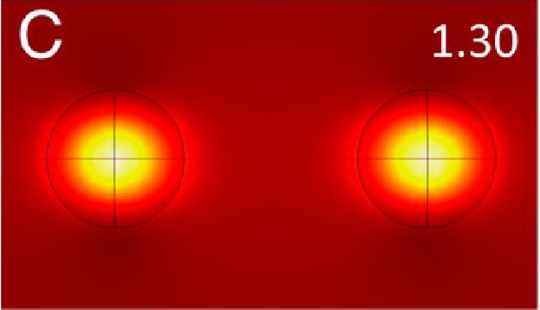
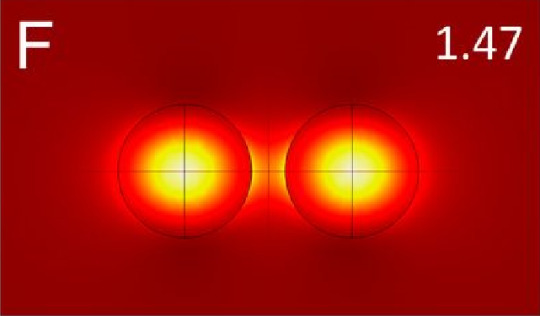
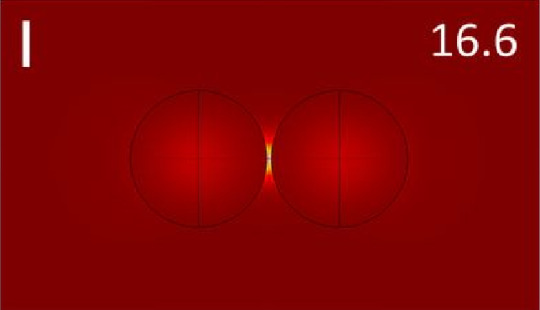
All this to say that this is a super cool quirk of science that you definitely should NOT try at home (the scientists doing the experiment to find out why this happened destroyed 12 different microwaves in the process lol)
#science#stem#science side of tumblr#stemblr#biology#biochemistry#chemistry#scientists#studyblr#physics#electricity
924 notes
·
View notes